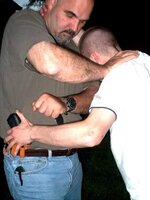- Messages
- 185
- Reactions
- 77
So I recently went through the process and got my CHL, but I had a question about when to go for the gun. I normally carry a 4-5 folding knife on me, a griptillian, and I was wondering if I was in a situation where there was a distance between the "perp" and me should I pull the knife first then go for the gun when they try to close the gap, or should I forget about the knife all together and wait for the proper time for the gun? I had someone tell me that I should never go for the knife if I have my gun on me. Any input would be greatly appreciated.
Thanks
Thanks













